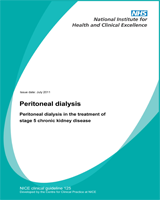Peritoneal Dialysis
NICE Clinical Guidelines, No. 125
Excerpt
Two main types of dialysis are available, haemodialysis and peritoneal dialysis. The main factors that determine what type of dialysis people with chronic kidney disease have are patient preferences about which treatment fits best within their lifestyle, availability of options within a service and clinical contraindications. Factors patients and carers may need to consider about peritoneal dialysis are: the ability to carry out dialysis themselves; the support services they need to carry out dialysis; integration of dialysis with work, school, hobbies, and social and family activities; opportunities to maintain social contacts; possible modifications to their home; the distance and time travelling to hospital; flexibility of daily treatment, diet and medication regimens; and possible changes to body image and physical activities because of dialysis access points.
Peritoneal dialysis can be delivered safely and effectively at home or at another location of the patient’s choice. Patients administer it themselves although children, and some adults, might need help from their families or carers. Patients must have a clean and hygienic place to exchange dialysis fluid and/or set up dialysis delivery devices either to have dialysis throughout the day (continuous ambulatory peritoneal dialysis [CAPD]) or overnight while they are asleep (automated peritoneal dialysis [APD] and assisted automated peritoneal dialysis [aAPD]). A small room or shed will be needed to store deliveries of dialysis fluid.
The proportion of people with chronic kidney disease (CKD) starting treatment on home- or hospital-based dialysis, and peritoneal or haemodialysis treatment, varies considerably. The proportion of people with chronic kidney disease using peritoneal dialysis ranges from 0–30% in adults, possibly because of variation in local practice and resources, and is as high as 56% in children.
There is currently no national guidance in England and Wales on supporting people to make informed decisions about renal replacement therapy, specifically peritoneal dialysis. Nor is there guidance on the role of aAPD in an integrated dialysis or renal replacement programme or individual patient pathway.
This short clinical guideline aims to improve the care of people with stage 5 CKD who need and want to receive dialysis, by making evidence-based recommendations on the role of peritoneal dialysis.
NICE clinical guidelines are recommendations about the treatment and care of people with specific diseases and conditions in the NHS in England and Wales.
This guidance represents the view of NICE, which was arrived at after careful consideration of the evidence available. Healthcare professionals are expected to take it fully into account when exercising their clinical judgement. However, the guidance does not override the individual responsibility of healthcare professionals to make decisions appropriate to the circumstances of the individual patient, in consultation with the patient and/or guardian or carer, and informed by the summary of product characteristics of any drugs they are considering.
Implementation of this guidance is the responsibility of local commissioners and/or providers. Commissioners and providers are reminded that it is their responsibility to implement the guidance, in their local context, in light of their duties to avoid unlawful discrimination and to have regard to promoting equality of opportunity. Nothing in this guidance should be interpreted in a way that would be inconsistent with compliance with those duties.
All rights reserved. This material may be freely reproduced for educational and not-for-profit purposes. No reproduction by or for commercial organisations, or for commercial purposes, is allowed without the express written permission of NICE.
